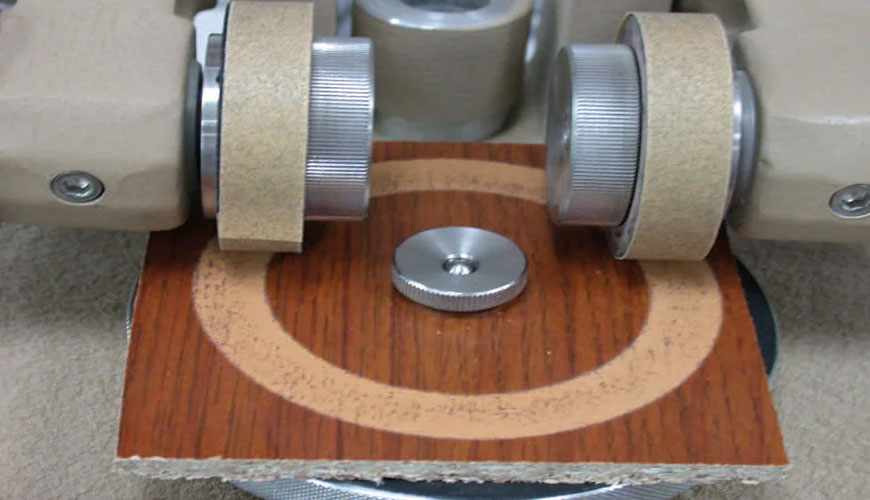

The “SATRA TM 174 Wear resistance - Rotary drum method” standard developed by SATRA, a research and technology center, describes a test method to determine the wear resistance of a material. This method is primarily applicable to polymeric shoe sole materials or suitable material cut from finished soles, but can also be used for any polymer-based sheet material.

In performing this test, a circular test specimen is placed in contact under a constant force with a rotating cylinder covered with a standard abrasive cloth. The sample is then moved along the length of the cylinder, allowing it to pass a helical contact path with the abrasive. The volume loss of the sample is determined as follows:
The SATRA TM 174 standard provides guidance on method selection. The severity of the abrasive is verified by abrading a reference material.
Wear resistance is the ability of a material to resist progressive loss of volume on its surface through mechanical actions such as repeated friction, sliding, or scraping. Wear-resistant materials minimize friction between mating surfaces, allowing parts to maintain their shape and integrity longer in applications that involve contact between load-bearing surfaces.
Manufacturers use a wide variety of engineered materials that minimize wear through low friction properties or self-lubrication, reducing mechanical wear while maintaining performance standards in the application.
The main factors affecting wear resistance and wear rate are the type of contact, environmental conditions and load. In terms of the type of contact, dynamic contact, e.g. sliding and rolling, the combination of mating surfaces, e.g. metal on metal, plastic on plastic and plastic on metal, the texture or roughness of the mating surfaces and the gap between the mating surfaces are important factors.
In terms of environmental conditions, important factors include temperature including heat from friction, exposure to sunlight, the presence of moisture or chemicals, and the presence and type of lubrication. In terms of load, the pressure of the applied load and the speed of dynamic movement are among the factors that affect wear resistance and wear rate.
Wear-resistant parts and components are critical in engineering applications where two load-bearing surfaces slide over each other, such as bearings, wear pads, gears and rotating shafts.
Wear resistance is also critical where mating surfaces must maintain their form to ensure function, for example in conformal contact applications where components are precision machined to maximize efficiency.
Meanwhile, many engineering applications require low-friction, wear-resistant materials such as thermoplastics. Engineering plastics generally have lower coefficients of friction than metals in the same or similar applications. Additionally, high-performance plastic materials often have self-lubricating properties, making them ideal for use in long-term wear and load-bearing applications.
Semi-crystalline thermoplastics, in particular, perform extremely well in wear, handling and friction applications due to their durability and sharp melting points. Acetal, nylon, ultra-high molecular weight polyethylene, polyphenylene sulfide, polyether ether ketone, and polyamide-imide are among the most wear-resistant and are among the most common wear-resistant thermoplastic materials used for parts and components that come into high-friction contact with metals.
Compared to metals or other contact surfaces, wear-resistant engineering plastics have several advantages in high-friction applications.
Among the numerous testing, measurement, analysis and evaluation studies it provides for businesses in various sectors, our organization also provides testing services in accordance with the SATRA TM 174 standard, with a trained and expert staff and advanced technological equipment.
To get an appointment, to get more detailed information or to request an evaluation, you can ask us to fill in our form and reach you.